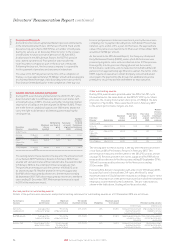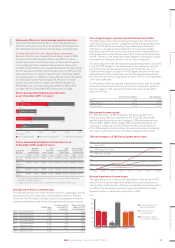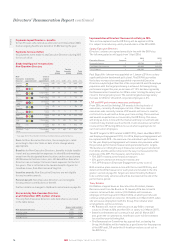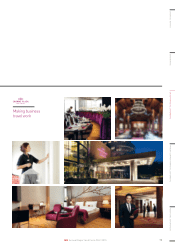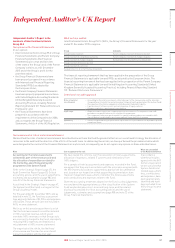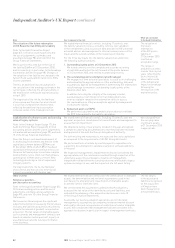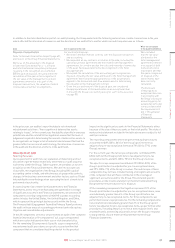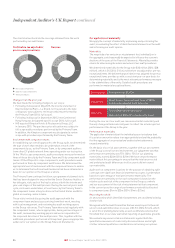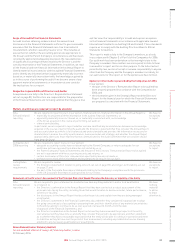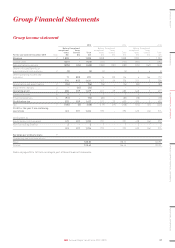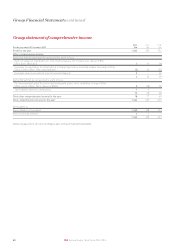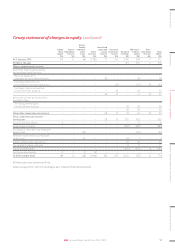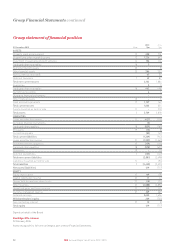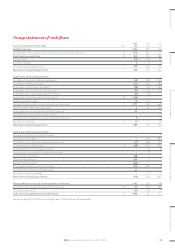Holiday Inn 2015 Annual Report Download - page 86
Download and view the complete annual report
Please find page 86 of the 2015 Holiday Inn annual report below. You can navigate through the pages in the report by either clicking on the pages listed below, or by using the keyword search tool below to find specific information within the annual report.
Independent Auditor’s UK Report continued
The charts below illustrate the coverage obtained from the work
performed by our audit teams.
60%
19%
21%
12%
29%
59%
RevenueProfit before tax adjusted for
pre-tax exceptional items
Full scope components
Specific scope components
Other procedures
Changes from the prior year
We have made the following changes to our scope:
• Following its disposal in May 2015, the income statement of
InterContinental Paris – Le Grand, for the period to the date
of disposal, was subject to review procedures performed by
the Primary Team (2014: full scope).
• Following its disposal in September 2015, InterContinental
Hong Kong was designated specific scope (2014: full scope).
• IHG acquired Kimpton Hotels & Restaurants Group, LLC
in January 2015. The purchase price allocation was subject to
full scope audit procedures performed by the Primary Team.
In addition, the Kimpton component was designated a review
scope with procedures performed by the Primary Team.
Involvement with component teams
In establishing our overall approach to the Group audit, we determined
the type of work that needed to be undertaken at each of the
components by us, as the Primary Team, or by component auditors
from other EY global network firms operating under our instruction.
Of the 19 full scope components, audit procedures were performed on
three of these directly by the Primary Team and 16 by component audit
teams. Of the 20 specific scope components, audit procedures were
performed on these by component audit teams. We determined the
appropriate level of involvement with the component teams to enable
us to determine that sufficient audit evidence had been obtained as a
basis for our opinion on the Group as a whole.
The Primary Team continued to follow a programme of planned visits
that has been designed to ensure that the Senior Statutory Auditor, or
her delegate, visits each of the key locations at both the interim and
year-end stages of the audit process. During the current year’s audit
cycle, visits were undertaken, at least twice, by the Primary Team to
the component teams at key locations in the United States and IHG’s
global accounting centre in India.
These visits involved discussing the audit approach with the
component team and any issues arising from their work, meeting
with local management, and reviewing key audit working papers
on the Group risk areas. The Primary Team interacted regularly with
the component teams, where appropriate, during various stages of
the audit, reviewed key working papers and were responsible for
the scope and direction of the audit process. This, together with the
additional procedures performed at Group level, gave us appropriate
evidence for our opinion on the Group Financial Statements.
Our application of materiality
We apply the concept of materiality in planning and performing the
audit, in evaluating the effect of identified misstatements on the audit
and in forming our audit opinion.
Materiality
The magnitude of an omission or misstatement that, individually or in
the aggregate, could reasonably be expected to influence the economic
decisions of the users of the Financial Statements. Materiality provides
a basis for determining the nature and extent of our audit procedures.
We determined materiality for the Group to be $30 million (2014: $28
million), which is 5% (2014: 5%) of profit before tax adjusted for pre-tax
exceptional items. We believe that profit before tax adjusted for pre-tax
exceptional items provides us with a consistent year-on-year basis for
determining materiality and is the most relevant performance measure
to the stakeholders of the entity. Detailed audit procedures are
performed on material exceptional items.
Adjust for pre-tax exceptional items of $819m
to determine adjusted profit before tax
Adjustment
Totals $593m (materiality basis)
Materiality of $30m (5% of materiality basis)
Materiality
Profit before tax $1,412m
Starting basis
During the course of our audit, we reassessed initial materiality and
the only change in final materiality was to reflect the actual reported
performance of the Group in the year.
Performance materiality
The application of materiality at the individual account or balance level.
It is set at an amount to reduce to an appropriately low level the probability
that the aggregate of uncorrected and undetected misstatements
exceeds materiality.
On the basis of our risk assessments, together with our assessment
of the Group’s overall control environment, our judgement was that
performance materiality was 75% (2014: 75%) of our planning
materiality, namely $23m (2014: $21m). We have set performance
materiality at this percentage to ensure that the total uncorrected
and undetected audit differences in all accounts did not exceed
our materiality.
Audit work at component locations for the purpose of obtaining audit
coverage over significant financial statement accounts is undertaken
based on a percentage of total performance materiality. The
performance materiality set for each component is based on the
relative scale and risk of the component to the Group as a whole
and our assessment of the risk of misstatement at that component.
In the current year, the range of performance materiality allocated
to components was $1m to $23m (2014: $1m to $21m).
Reporting threshold
An amount below which identified misstatements are considered as being
clearly trivial.
We agreed with the Audit Committee that we would report to them all
uncorrected audit differences in excess of $1.5m (2014: $1.4m), which
is set at 5% of planning materiality, as well as differences below that
threshold that, in our view, warranted reporting on qualitative grounds.
We evaluate any uncorrected misstatements against both the
quantitative measures of materiality discussed above and in light
of other relevant qualitative considerations in forming our opinion.
84 IHG Annual Report and Form 20-F 2015


